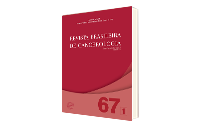Evaluation of Taste Perception of Oncological Patients: Relationship with Personal and Clinical Variables and Comparison with a Control Group
DOI:
https://doi.org/10.32635/2176-9745.RBC.2021v67n1.994Keywords:
Neoplasms, Medical Oncology, ntineoplastic Agents/adverse effects, Taste, DysgeusiaAbstract
Introduction: Antineoplastic treatment can cause side effects that impair the patients’ food intake and nutritional status. Objective: To evaluate the taste perception in patients undergoing cancer treatment, to relate it to personal and clinical variables and to compare with taste perception in healthy individuals. Method: Cross-sectional study with 50 individuals undergoing cancer treatment and another 50 individuals in the control group. To assess taste perception, participants received food samples and were asked about sweet, bitter, salty and sour flavors. The intensity of the flavor was assessed using a scale from 1 to 5. Results: Patients undergoing cancer treatment perceived the flavors of the following foods more strongly: dulce de leche (4.48±1.0 vs. 3.78±0.9; p<0.05), guava (4.10±1.0 vs. 3.52±0.9; p<0.05), lemon juice (4.42±0.9 vs. 2.86±1.0; p<0.05), passion fruit juice (3.76±1.2 vs. 2.56±1.0; p<0.05) and coffee (4.42±0.8 vs. 3.14±0.9; p<0.05). The foods: cassava starch, natural yogurt, arugula and chicory were perceived with less intensity when compared to the control group. Among the four flavor categories evaluated, the foods in the salty group were the ones that least differed in terms of the taste perception and sour and bitter foods were perceived more distinctly between the groups. Conclusion: The present study is pioneer in evaluating the taste perception using food, instead of standardized solutions, and through this technique, significant differences were identified in the intensity of taste perception of individuals undergoing cancer treatment.









